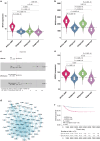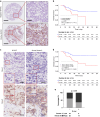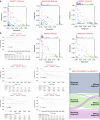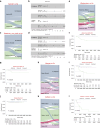Identification of MYCN non-amplified neuroblastoma subgroups points towards molecular signatures for precision prognosis and therapy stratification
- PMID: 38553589
- PMCID: PMC7616008
- DOI: 10.1038/s41416-024-02666-y
Identification of MYCN non-amplified neuroblastoma subgroups points towards molecular signatures for precision prognosis and therapy stratification
Abstract
Background: Despite the extensive study of MYCN-amplified neuroblastomas, there is a significant unmet clinical need in MYCN non-amplified cases. In particular, the extent of heterogeneity within the MYCN non-amplified population is unknown.
Methods: A total of 1566 samples from 16 datasets were identified in Gene Expression Omnibus (GEO) and ArrayExpress. Characterisation of the subtypes was analysed by ConsensusClusterPlus. Independent predictors for subgrouping were constructed from the single sample predictor based on the multiclassPairs package. Findings were verified using immunohistochemistry and CIBERSORTx analysis.
Results: We demonstrate that MYCN non-amplified neuroblastomas are heterogeneous and can be classified into 3 subgroups based on their transcriptional signatures. Within these groups, subgroup_2 has the worst prognosis and this group shows a 'MYCN' signature that is potentially induced by the overexpression of Aurora Kinase A (AURKA); whilst subgroup_3 is characterised by an 'inflamed' gene signature. The clinical implications of this subtype classification are significant, as each subtype demonstrates a unique prognosis and vulnerability to investigational therapies. A total of 420 genes were identified as independent subgroup predictors with average balanced accuracy of 0.93 and 0.84 for train and test datasets, respectively.
Conclusion: We propose that transcriptional subtyping may enhance precision prognosis and therapy stratification for patients with MYCN non-amplified neuroblastomas.
© 2024. The Author(s).
Conflict of interest statement
The authors declare no competing interests.
Figures








Similar articles
-
Predicting amplification of MYCN using CpG methylation biomarkers in neuroblastoma.Future Oncol. 2021 Dec;17(34):4769-4783. doi: 10.2217/fon-2021-0522. Epub 2021 Nov 9. Future Oncol. 2021. PMID: 34751044
-
Transcript signatures that predict outcome and identify targetable pathways in MYCN-amplified neuroblastoma.Mol Oncol. 2016 Nov;10(9):1461-1472. doi: 10.1016/j.molonc.2016.07.012. Epub 2016 Aug 18. Mol Oncol. 2016. PMID: 27599694 Free PMC article.
-
Distinct transcriptional MYCN/c-MYC activities are associated with spontaneous regression or malignant progression in neuroblastomas.Genome Biol. 2008 Oct 13;9(10):R150. doi: 10.1186/gb-2008-9-10-r150. Genome Biol. 2008. PMID: 18851746 Free PMC article.
-
Biological categories of neuroblastoma based on the international neuroblastoma pathology classification for treatment stratification.Pathol Int. 2021 Apr;71(4):232-244. doi: 10.1111/pin.13085. Epub 2021 Mar 3. Pathol Int. 2021. PMID: 33657257 Review.
-
Cross-study analysis of gene expression data for intermediate neuroblastoma identifies two biological subtypes.BMC Cancer. 2007 May 25;7:89. doi: 10.1186/1471-2407-7-89. BMC Cancer. 2007. PMID: 17531100 Free PMC article. Review.
Cited by
-
Development of a prognostic model for overall survival in neuroblastoma based on Schwann cell-specific genes, clinical predictors, and MYCN amplification.Transl Cancer Res. 2025 May 30;14(5):2677-2689. doi: 10.21037/tcr-24-2048. Epub 2025 May 26. Transl Cancer Res. 2025. PMID: 40530123 Free PMC article.
-
Identification of Novel Molecular Panel as Potential Biomarkers of PAN-Gastrointestinal Cancer Screening: Bioinformatics and Experimental Analysis.Biology (Basel). 2025 Jul 2;14(7):803. doi: 10.3390/biology14070803. Biology (Basel). 2025. PMID: 40723362 Free PMC article.
-
Development of Dual Aurora-A and Aurora-B Degrading PROTACs for MCYN-Amplified Neuroblastoma.ChemMedChem. 2025 Mar 3;20(5):e202400703. doi: 10.1002/cmdc.202400703. Epub 2024 Nov 20. ChemMedChem. 2025. PMID: 40785977
-
Targeting the ubiquitin-proteasome system: a novel therapeutic strategy for neuroblastoma.Front Oncol. 2024 Sep 26;14:1443256. doi: 10.3389/fonc.2024.1443256. eCollection 2024. Front Oncol. 2024. PMID: 39391247 Free PMC article. Review.
-
Novel variants of the ATRX gene identified in MYCN non-amplified Neuroblastoma in Brazilian patients.Clinics (Sao Paulo). 2025 Apr 25;80:100652. doi: 10.1016/j.clinsp.2025.100652. eCollection 2025. Clinics (Sao Paulo). 2025. PMID: 40286729 Free PMC article.
References
MeSH terms
Substances
Grants and funding
LinkOut - more resources
Full Text Sources
Medical
Miscellaneous

